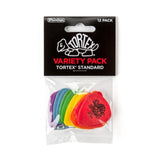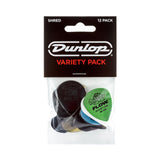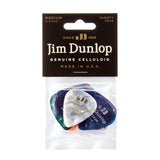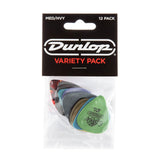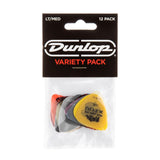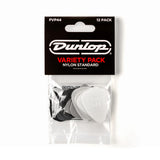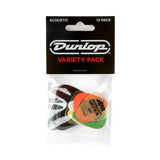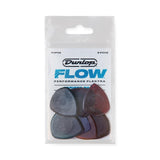A Capo is a relatively inexpensive yet endlessly versatile tool that can massively enhance your creativity with your instrument. When utilised in the correct manner, this bit of kit can really open up new sonic worlds for your guitar sound, completely changing tired old chord progressions and making barre chords and more complex shapes a lot easier to play.
What is a Capo?
The name capo derives from the Italian word capodastro which translates as the ‘head of fretboard’. The capo is typically fastened across all the strings of a guitar, ukulele, or very rarely, a bass guitar. It lets you play songs in different keys whilst still using your knowledge of open chord shapes, and opens up some interesting tonal varieties when using ringing open strings.

The capo changes the pitch of the open strings in the chord shape, essentially having the same effect as retuning all of your strings up. That said any fretted notes are the same, so playing the seventh fret of the E string will still be a B note for any position at or below the seventh fret. A capo will also slightly alter the timbre of the string as it essentially shortens the scale length of the instrument.
History of the Capo
The first capo was patented by James Ashborn in the year 1850, and although there had been capo designs prior to that, Ashborn’s design stuck due to its lever and cam to tighten and apply pressure, holding it securely on the guitar neck. As the guitar moved into the twentieth century various capo designs started to become available as the instrument grew in popularity.

Jim Dunlop brought out a lever action capo in the 60s, following it up with the now classic Dunlop Pickers Pal Capo which managed to utilise pressure points to ensure an even clamp across the fretboard. Arguably the next great development in capo design came with the Kyser quick Change Capo, which solved the majority of problems with quickly adding and removing the capo thanks to its spring-loaded, trigger style design that’s still popular to this day.
Why use a Capo?
The primary reason to use a capo is to play easily in different keys. If you know a song in standard tuning you can quickly and easily change the key of it by simply applying the capo, using it as your new nut, and playing the same chord shapes you already know. Another excellent way to use the capo is during recording, where rather than having two guitars play the same position, you can use a capo to change the voicing of the chords.

For example, imagine you have two guitarists who are playing chords on your recording, but it all sounds a bit dull. Taking a I IV V chord progression in the key of E as an example, guitarist one will play E A B7. Guitarist two places a capo on the fourth fret, and can play the same progression using the C F G7 chord shapes. Both the same chords, but different voicing on each guitar will lend a much fuller and more interesting sound!
Selecting a Guitar Capo
There are various types of capo available and most of them will work on a variety of instruments, there are however certain aspects of capo design you need to bear in mind. A capo that’s designed for a 6 string guitar may not have the same effect on a 12 string due to the increased pressure required so here’s a few things to bear in mind when purchasing a capo.
Fretboard Radius
Some guitars have a radiused fretboards, which means there is a slight curve across the fretboard. Your capo will need a similar radius or you run the risk of improperly clamped strings. An electric guitar will tend to have a radiused fretboard, whereas a classical acoustic will be completely flat. The majority of capos will describe what instrument they are primarily intended for, so be mindful of that when making your choice.
Capo Mounting
Are you going to have your capo permanently mounted to your guitar, or will you need to switch things up quickly? Some capos will need two hands to take them off, whereas others will simply require you to change position with just one. So called ‘trigger capos’ are the best for players who need quick capo changes, as you can grab them one handed and move them around. At the expense of quick changes however, trigger capos are often culpable for not providing even pressure across all strings due to their design.

A lever or ‘cradle style’ capo is considered quite old fashioned these days, however they are hugely advantageous in terms of pressure applied to the strings, reliably clamping down evenly. This ensures that you don’t get any dead notes that won’t ring out, and also allows you to prevent tuning issues that come from capos not applying enough pressure across the fretboard.
Best Guitar Capo
Now that you know pretty much everything there is to know about the humble guitar capo it’s time for our pick of the best guitar capos available today!
Ernie Ball Axis Capo
The Ernie Ball Axis Capo allows for quick, one handed changes and is compatible with the majority of electric and acoustic guitars. It’s two sided design gives you options for both curved and flat fretboards, meaning this will sit just as well on your electric as it will your classical guitar. It’s also available in a huge variety of colours that look awesome against your more usual black and silver offerings.
Shop Ernie Ball Axis Capo here.
G7th Performance 3 Capo
The G7th Performance 3 Capo utilises something called Unique Tension Control, which allows you to control the amount of pressure you apply on your strings by simply squeezing the capo. This means you can always get the perfect amount of pressure on a variety of instruments, making it incredibly versatile. It also features Adaptive Radius Technology, which makes sure that the capo fits a variety of guitar radius, perfectly clamping your strings down evenly to prevent any being pulled out of tune.
Shop G7th Performance 3 Capo here.
Jim Dunlop Toggle Capo
Toggle Capos are an older technology, but there's still plenty of guitar players who swear by them. The Jim Dunlop Toggle Capo features an adjustable strap allows you to set the tension, which means you can find the perfect balance anywhere on the fretboard. They're also super easy to take on and off, making them perfect for regularly gigging guitar players who need to change keys quickly.
Shop Jim Dunlop Toggle Capo here.
D’Addario NS Artist Capo
The D’Addario NS Artist Capo uses a patented, Trigger-Action geometry to give you a super quick changeover time, with the handle being remarkebly easy to press down whilst still holding solidly on the neck. A micrometer tension adjustment control allows you to to make small adjustments to prevent your strings being pulled out of tune, applying the perfect amount of pressure for your instrument. It also features a pick holder bracket and a micro tuner (sold separately) mounting bracket, allowing this capo to do several jobs at once.
Shop D'Addario NS Artist Capo here.
Rotosound GC200 Trigger Capo
The Rotosound GC200 Guitar Trigger Capo is a spring loaded, alloy constructed capo designed for easy one handed operation. It’s compatible with the vast majority of guitar types, with a silicon cushion that helps protect the finish on your neck. Great for those on a budget, the GC200 delivers great performance without costing the earth.
Shop Rotosound GC200 Trigger Capo here.
Fender Smart Guitar Capo
It seems like everything is 'smart' nowadays, and now that goes for the humble guitar capo too! There's a lot to love about the Fender Smart Guitar Capo though. For starters you can remove and reapply it in seconds with one hand, making it great for quick key changes. The pantent pending design also ensures that the perfect amount of tension is applied wherever you place it, meaning no duff notes at your next show.
Shop Fender Smart Guitar Capo here.
Jim Dunlop Bill Russell Elastic Guitar Capo
Another older technology, the Jim Dunlop Bill Russell Elastic Guitar Capo is specially designed for guitars with a curved radius fretboard. As well as being low cost and easy to use, this elastic capo has a super low profile and low weight so it won't get in the way your performance. It also looks great with its boho textured design and is sure to have other guitarists enquiring about it!
Shop Jim Dunlop Bill Russell Elastic Guitar Capo here.
In Conclusion
So there we have it, the Best Guitar Capos available today. If you’ve never used a capo before, you might be surprised at just how intuitive they are as tools, as well as the new avenues they can open up in your guitar playing. There is a school of thought in the guitar world that capos are ‘cheating’ or for guitarists ‘who can’t play barre chords’ but the truth is it is simply a tool to augment your playing. Like any other guitar accessory, it’s all in how you use it.
Learn More
The guitar capo works a lot like a guitar nut, find out more about those with our Guitar Setup Guide.
Learn more about your strings with our String Gauge Guide.
Kluson Tuners will provide an excellent upgrade on your stock guitar tuners.


















